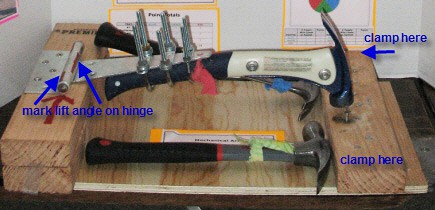Abstract
How much force does it take to drive a nail through different types of wood? In this project you'll build a simple test apparatus to swing a hammer reproducibly so you can find out.Summary
Sources
- The idea for the hammer test apparatus is from an entry to the 2007 San Mateo County Science Fair (author's name not provided).

Objective
The goal of this project is to measure how much force is needed to pound nails into different kinds of wood.Introduction
It takes a lot of energy to drive a nail into a solid piece of wood. The hammer drives the nail through the structure of the wood. As the nail drives through, it pushes aside the cellulose fibers of the wood, which are held strongly together by lignin. As a result, the nail is held firmly in the wood. In order to pull the nail out, you need to overcome frictional forces between the wood and the nail along its entire length.
Wood from different types of trees has different properties. Maple wood, for example, is very hard. In fact, it is easy to bend nails when trying to pound them into maple. Pine lumber, on the other hand, is soft enough that you can mark it with your fingernails.
You may have run across the terms "hardwood" and "softwood" in reference to trees. In general, softwood trees do have less dense wood than hardwood trees, but the classification is actually made on the basis of the seed structure. Hardwood trees (also called angiosperms) have a covering over the seed. Softwood trees (also called gymnosperms) have no covering over the seed. For more details, see the webpage, "What's the Difference Between a Hardwood and a Softwood?" (HowStuffWorks Inc, 1998-2007).
In this project you will build a simple test apparatus that can reproducibly swing a hammer. How many strokes will it take to drive a nail through different types of wood?
Terms and Concepts
To do this project, you should do research that enables you to understand the following terms and concepts:- Structure of wood
- Cellulose
- Lignin
- Hardwood (angiosperm)
- Softwood (gymnosperm)
- Friction
Questions
- What is the difference between a hardwood and a softwood?
Bibliography
- Armstrong, W.P., date unknown. The Anatomy Of Wood: Microscopic Structure And Grain Of Wood, Wayne's Word, An Online Textbook of Natural History. Retrieved April 6, 2007.
- HowStuffWorks, Inc., 1998-2007. What Is the Difference Between a Hardwood and a Softwood? HowStuffWorks.com. Retrieved April 6, 2007.
Materials and Equipment
To do this experiment you will need the following materials and equipment:- Large hinge
- 3 U-bolts
- 6 hex nuts
- 15 #8 or #10 wood screws
- Power drill,
- Bits for screw pilot hole and countersinking for screw head
- Screwdriver, (either hand-held, or a screwdriver bit for the drill)
- Hammer
- Nails
- 2 6" lengths of 2 × 4
- One 12" length of 2 × 4
- Small piece of 1/2 in plywood (roughly 20" × 6")
- Short lengths (about 12" each) of different types of wood for testing, e.g.:
- Pine
- Fir
- Oak
- Maple
- Birch
- Note: all test lumber should be of the same thickness.
- 2 "C" clamps
- One or two potatoes
Experimental Procedure
- Do your background research so that you are knowledgeable about the terms, concepts, and questions, above.
- Build the test apparatus for hammering nails, using the illustration as a guide.

- Tips for building the test apparatus:
- Note: the dimensions given are not from the apparatus shown in the picture. To save on wood, the apparatus we describe is about the same length, but narrower than the one in the picture.
- The size of the plywood base may need to be adjusted to fit the length of your hammer. Ideally, the head of the hammer should fall mid-way along the width of the right-hand 2 × 4.
- Height: When clamped in place on the hinge, the face of the hammer should be parallel to and resting on the surface of a piece of test lumber placed on top of the right-hand 2 × 4.
- The shorter 2 × 4's go on the left. The longer 2 × 4 goes on the right, centered on the plywood. The test lumber will be clamped in place on each of the protruding ends.
- Attach the two bottom 2 × 4's with 2 in flat-head wood screws coming up through the underside of the plywood platform. Pre-drill starter holes through the plywood and 2 × 4's. Make a larger, shallow hole in the plywood for the screw head (i.e., countersink). That way the plywood base can rest flat on a surface with no screw heads sticking out.
- Attach the top 2 × 4 (on the left) with 3 in wood screws through top.
- Attach the hinge to the center of the left hand 2 × 4, as shown in the illustration.
- Use the three U-bolts to attach the hammer to the hinge, as shown in the illustration.
- Mark the hinge (as shown in the picture) so that the hammer is brought to the same height for each stroke.
- Clamp the piece of lumber to be tested in place on top of the right-hand 2 × 4.
- Cut a 3/4" slice of potato. Center it where the hammer will strike on the test lumber. The potato slice will hold the nail upright (saves your fingers).
- Poke the nail through the center of the potato so that it stands upright. Adjust the position, if necessary, so that the hammer hits the nail squarely on the head.
- Count how many strokes it takes to hammer the nail into the wood. Tip: you'll need to take the nail out, so don't pound it all the way in. Leave enough sticking out so that you can easily grab it with the hammer's claw end to pull it out.
- Move the test lumber so that you can make another trial. Do at least three trials for each type of lumber.
- Calculate the average number of strokes needed to pound a nail into each type of wood. Make a bar graph to show your results. The average number of strokes should go on the y-axis, and the type of wood on the x-axis.
Ask an Expert
Global Connections
The United Nations Sustainable Development Goals (UNSDGs) are a blueprint to achieve a better and more sustainable future for all.
Variations
- The end grain should tell you something about the hardness of the wood. Softwood trees grow faster than hardwood trees, so the grain (which is a product of the tree's growth rings) will be farther apart in softwood lumber than in hardwood lumber. See the article on the anatomy of wood (Armstrong, date unknown) for more information on how lumber is cut from trees and the resulting grain patterns. Is there a correlation between the grain pattern and the number of strokes needed to drive a nail into the wood? How about between the density of the wood and the number of strokes needed to drive a nail into the wood?
- You could try using nails of different diameters. As the nail diameter grows larger, how would you expect the force needed to drive the nail into the wood would change?
- When you put the test apparatus together, you used pre-drilled holes for the wood screws. The holes were smaller than the diameter of the screws, but they made it much easier to drive the screws in. What happens if you pre-drill holes for the nails?
- In this experiment you used a single hammer and changed the types of wood. You could also investigate what happens if different hammers are used to drive the nails.
- You could also investigate the holding force of nails in different types of wood. How hard is it to remove the nails? Think of a way to quantify the effort needed to remove the nails and make it part of your study as well.
Careers
If you like this project, you might enjoy exploring these related careers:










